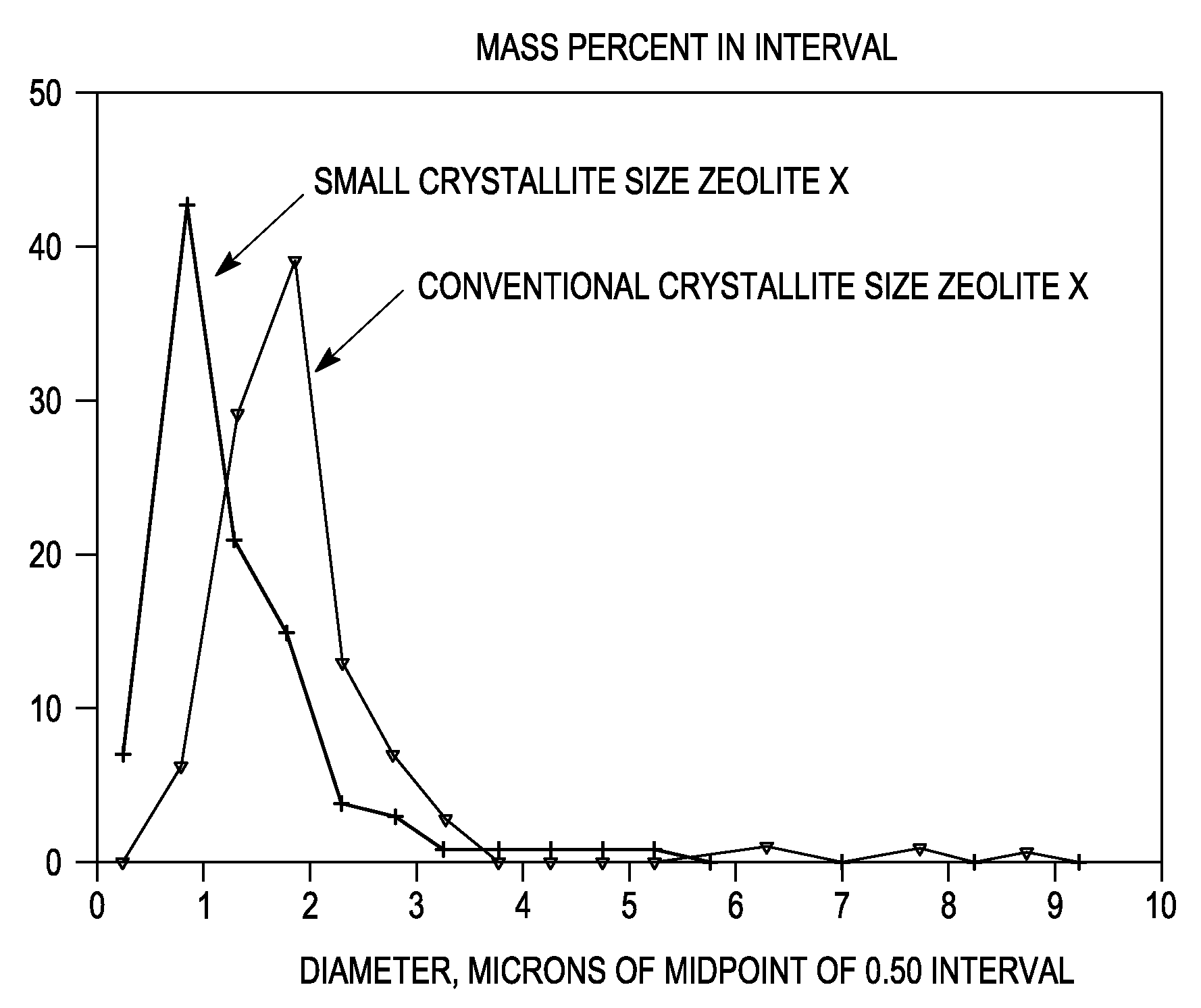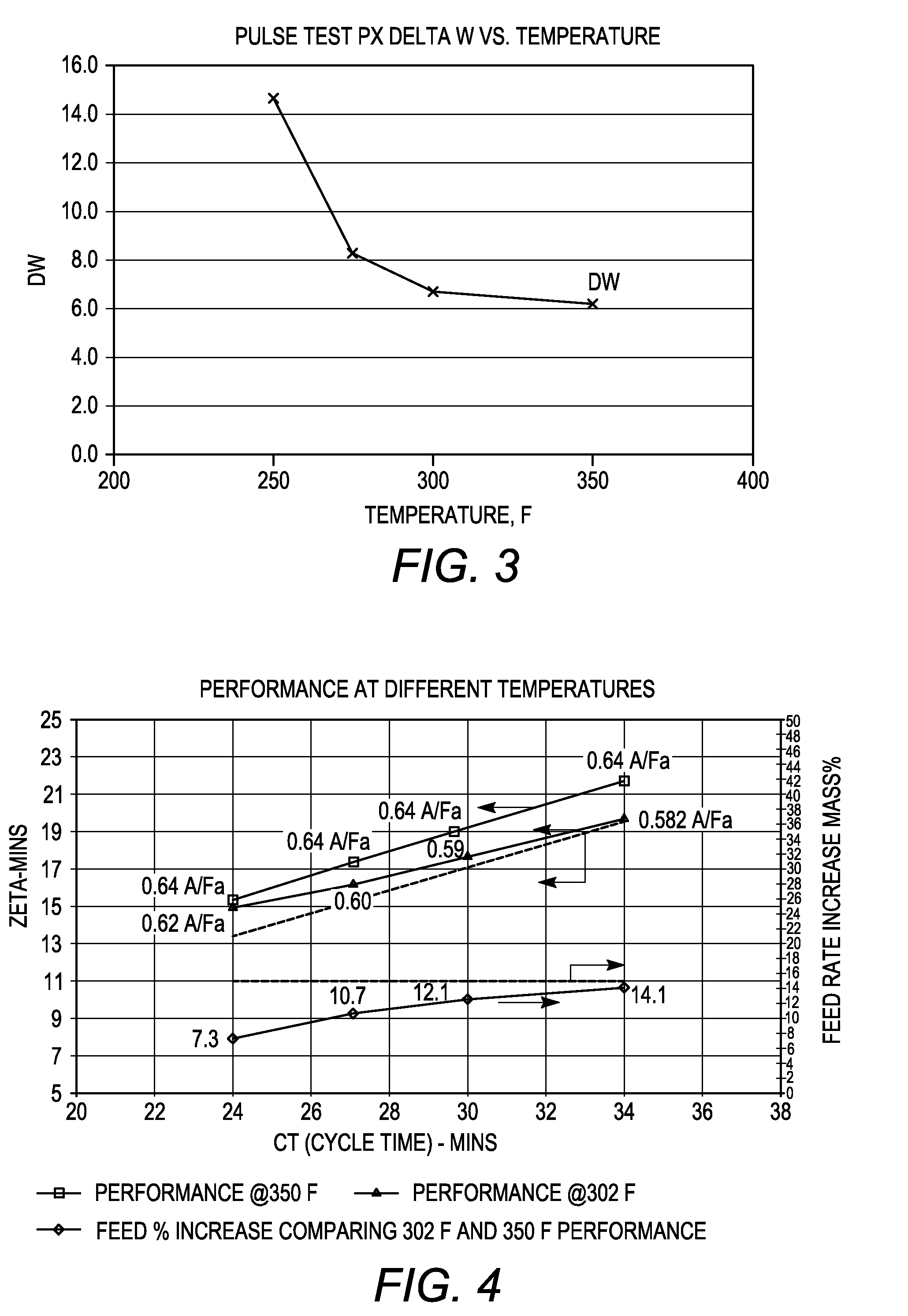Binderless adsorbents comprising nano-size zeolite x and their use in the adsorptive separation of para-xylene
- Summary
- Abstract
- Description
- Claims
- Application Information
AI Technical Summary
Benefits of technology
Problems solved by technology
Method used
Image
Examples
example 1
Synthesis of Nano-Size Zeolite X
[0083]Sodium aluminate (29 grams, Pfaltz and Bauer) was dissolved in 368 grams of deionized water (DI-H2O) in a large beaker. The beaker and contents were allowed to mix in an ice water bath and cool to 0° C. Meanwhile, NaOH (112 grams) was dissolved in 100 grams of DI-H2O in another beaker. Sodium silicate (420 grams, Oxychem Grade 40, about 29% SiO2 and 9% Na2O) was then added to this second beaker and the beaker was likewise allowed to mix in an ice water bath until the temperature reached 0C. When both solutions were at 0° C., the solution in the first beaker was added to the solution in the second beaker with vigorous mixing. The combined solution was allowed to mix in an ice water bath at 0° C. for 1 hour. The clear solution was then transferred to a large Teflon bottle and allowed to come to room temperature slowly (e.g., over several hours), and the bottle was left to age quiescently overnight at room temperature. The bottle was thereafter pla...
example 2
Synthesis of Binderless Adsorbent Particles
[0084]The nano-size zeolite X made as described in Example 1 was combined with a known amount of commercially available kaolin and water to form an extrudable paste, which was then extruded to form composite pellets with 50-90% nano-size zeolite X in kaolin. The composite was then dried at 100° C. and finally calcined at >600° C. in order to convert the binder kaolin to meta-kaolin. The binder meta-kaolin was then converted to zeolite X by hydrothermal treatment in 2 Na / Al (from meta-kaolin) for up to 10 hours with mild agitation.
example 3
Ion Exchange of Adsorbent Particles Comprising Nano-Size and Converted Zeolite X
[0085]The adsorbent particles obtained in Example 2 and comprising nano-size zeolite X and converted zeolite X, both in their sodium form, were subjected to ion exchange with barium and potassium ions. A 100 gram sample of the adsorbent particles was loaded into a glass column and washed with water. A barium chloride / potassium chloride solution (215 grams of BaCl2.2H2O, 0-5.0 gram of KCl and 1400 grams of water, pH=10) was then introduced into the column at a flow rate of 10 ml / min and a column temperature of 90° C. The adsorbent bed was then cooled to room temperature and washed until chloride-free. The column was emptied and the adsorbent allowed to dry overnight. The dried adsorbent was thereafter heated to remove excess water and obtain a desired hydration level.
PUM
| Property | Measurement | Unit |
|---|---|---|
| Temperature | aaaaa | aaaaa |
| Temperature | aaaaa | aaaaa |
| Temperature | aaaaa | aaaaa |
Abstract
Description
Claims
Application Information
 Login to View More
Login to View More - R&D
- Intellectual Property
- Life Sciences
- Materials
- Tech Scout
- Unparalleled Data Quality
- Higher Quality Content
- 60% Fewer Hallucinations
Browse by: Latest US Patents, China's latest patents, Technical Efficacy Thesaurus, Application Domain, Technology Topic, Popular Technical Reports.
© 2025 PatSnap. All rights reserved.Legal|Privacy policy|Modern Slavery Act Transparency Statement|Sitemap|About US| Contact US: help@patsnap.com



